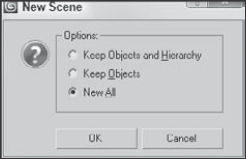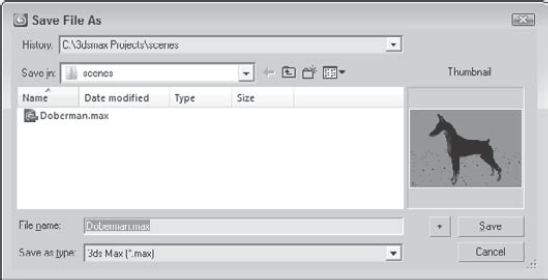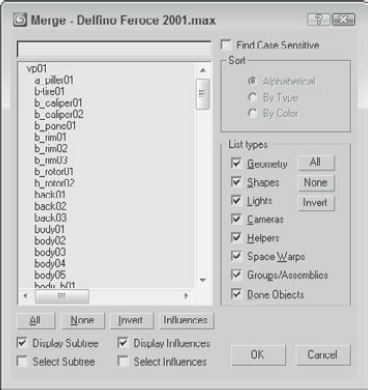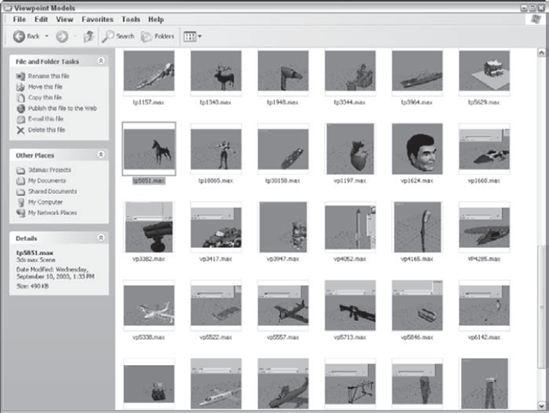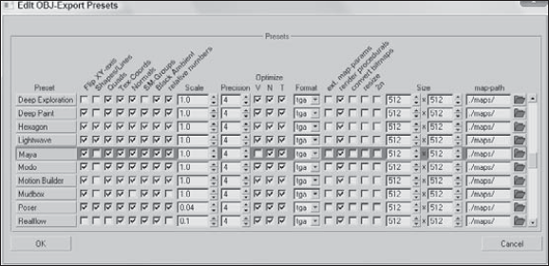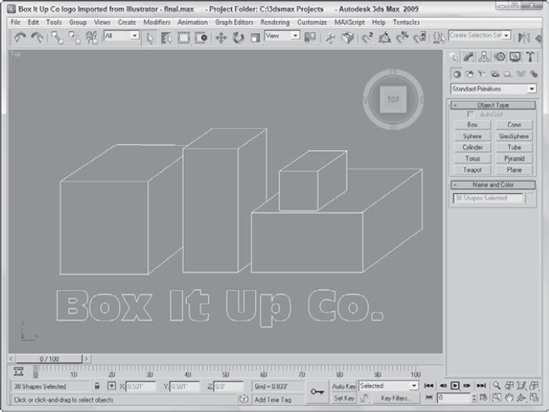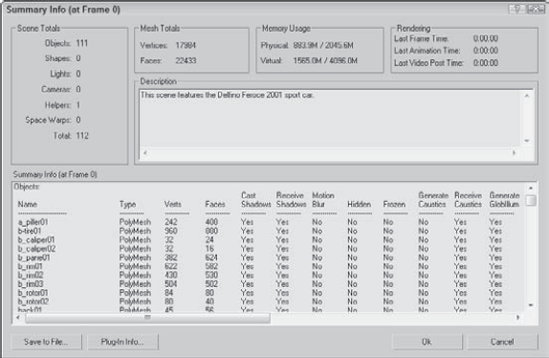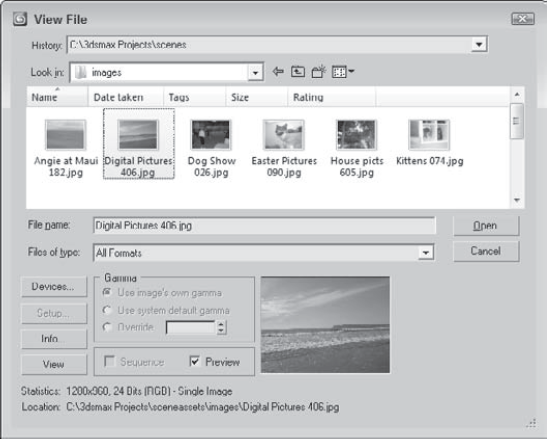Complex scenes can end up being a collection of hundreds of files, and misplacing any of them will affect the final output, so learning to work with files is critical. This chapter focuses on working with files, whether they are object files, texture images, or background images. Files enable you to move scene pieces into and out of Max. You can also export and import files to and from other packages.
Of all the different file types and formats, there is one file type that you probably will work with more than any other—the Max format. Max has its own proprietary format for its scene files. These files have the .max extension and allow you to save your work as a file and return to it at a later time. Max also supports files saved with the .chr extension used for character files.
When Max starts, a new scene opens. You can start a new scene at any time with the File
Starting a new scene deletes the current scene, but Max asks you whether you want to keep the objects and hierarchy, keep the objects, or make everything new, as shown in Figure 3.1. Starting a new scene with the File
After you start up Max, the first thing you should learn is how to save your work. After a scene has changed, you can save it as a file. Before a file is saved, the word "Untitled" appears in the title bar; after you save the file, its name appears in the title bar. Choose File
The Save File As dialog box keeps a history list of the last five directories that you've opened. You can select these directories from the History drop-down list at the top of the dialog box. The buttons in this dialog box are the standard Windows file dialog box buttons used to go to the last folder visited, go up one directory, create a new folder, and to view a pop-up menu of file view options. The options include Thumbnails, Tiles, Icons, List, and Details. The thumbnail option displays an image of the active viewport, which is useful when you open files, but when you save files for the first time, the thumbnail is blank.
Note
If you try to save a scene over the top of an existing scene, Max presents a dialog box confirming this action.
Tip
Use the auto increment file number and Save button to save progressive versions of a scene. This is an easy version control system. If you need to backtrack to an earlier version, you can.
The File menu also includes an option to Save Selected. This option saves the current selected objects to a separate scene file. If you create a single object that you might use again, select the object and use the Save Selected option to save it to a directory of models. A File
Another useful feature for saving files is to enable the Auto Backup feature in the Files panel of the Preference Settings dialog box. This dialog box can be accessed with the Customize
When you want to open a file you've saved, you may do so by choosing File
If Max cannot locate resources used within a scene (such as maps) when you open a Max file, then the Missing External Files dialog box, shown in Figure 3.3, appears, enabling you to Continue without the file or to Browse for the missing files. If you click the Browse button, the Configure External File Paths dialog box opens, where you can add a path to the missing files.

Figure 3.3. The Missing External Files dialog box identifies files for the current scene that are missing.
If you open a file that includes features that have changed since the previous version, then Max presents an obsolete data format warning statement. Resaving the file can fix this problem. However, if you save a file created with a previous version of Max as a Max 2009 scene file, then you won't be able to open the file again in the previous versions of Max.
Tip
You can disable the Obsolete File Message in the Files panel of the Preference Settings dialog box.
The most recently opened scenes are listed in the File
By default, Max opens to the Scenes directory where Max is installed, but you can set a Project Folder that may be located anywhere on your local hard drive or on the network. All file dialog boxes will then open to the new project folder automatically. The File
Within the project folder's root is a file with the .mxp extension named the same as the project folder. This file is a simple text file that can be opened within a text editor. Editing this file lets you define which subfolders are created within the project folder. The defined project folder also is visible within the title bar.
If you happen to create the perfect prop in one scene and want to integrate the prop into another scene, you can use the Merge menu command. Choose File
Note
The Merge dialog box is very similar to the Select Objects dialog box.
If you ever get involved in a modeling duel, then you'll probably be using the File
By archiving a Max scene along with its reference bitmaps, you can ensure that the file includes all the necessary files. This is especially useful if you need to send the project to your cousin to show off or to your boss and you don't want to miss any ancillary files. Choose File
Saving an archive as a ZIP file compiles all external files, such as bitmaps, into a single compressed file. The File Type drop-down list of the File Archive dialog box also includes an option to create a List of Files. When you select this file type, a text file is created that lists all relevant files and their paths.
The Files panel of the Preference Settings dialog box holds the controls for backing up, archiving, and logging Max files. You can open this dialog box using the Customize
The Files panel includes several options that define how to handle files. The first option is to Convert file paths to UNC (Universal Naming Convention). This option displays file paths using the UNC for any files accessed over a mapped drive. The Convert local file paths to Relative option causes all paths to be saved internally as relative paths to the project folder. This is useful if all files you access are in the same folder, but if you use files such as bitmaps from a different folder, then be sure to disable this option.
The next option is Backup on Save. When you save a file using the File
Another option to prevent overwriting your changes is the Increment on Save option. This option adds an incremented number to the end of the existing filename every time it is saved. This retains multiple copies of the file and is an easy version-control method for your scene files. This way, you can always go back to an earlier file when the client changes his mind. With this option enabled, the MaxBack.bak file isn't used.
The Compress on Save option compresses the file automatically when it is saved. Compressed files require less file space but take longer to load. If you're running low on hard drive space, then you'll want to enable this option.
Tip
Another reason to enable the Compress on Save option is that large files (100MB or greater) load into the Network Queue Manager much more quickly when compressed for network rendering.
The Save Viewport Thumbnail Image option saves a 64 × 64-pixel thumbnail of the active viewport along with the file. This thumbnail is displayed in the Open dialog box and can also be seen from Windows Explorer on Windows XP, as shown in Figure 3.6. Saving a thumbnail with a scene adds about 9K to the file size.
Warning
Although thumbnails appear when viewed from within Windows XP, they do not appear in Windows Vista.
Tip
The Save Viewport Thumbnail Image option is another good option to keep enabled. Thumbnails help you to find scene files later, and nothing is more frustrating than seeing a scene's filename without a thumbnail.
Note
Windows Vista doesn't currently support displaying Max thumbnails.
In addition to a thumbnail, Max also offers an option to save the Schematic View with the file. Although Max can generate a new Schematic View from an existing file, saving the Schematic View with the file is quicker if you work with this view often. Saving File Properties with the file is also helpful, but be warned that saving this extra info with the file increases its file size slightly. Still, doing so is worth the effort because you can easily locate and understand the scene file later on.
When a Max file created in a previous version of Max is opened, a warning dialog box appears that says, "Obsolete data format found—Please resave file." To eliminate this warning, disable the Display Obsolete File Message option. The warning dialog box also includes an option to Don't Display Again that enables this option when selected.
When textures are updated, the Reload textures on change option forces the textures to be reloaded when they are altered. This slows your system while Max waits for the textures to reload, but offers the latest look immediately.
The Recent Files in File Menu option determines the number of recently opened files that appear in the File
The Auto Backup feature in Max can save you from the nightmare of losing all your work because of a system crash. With Auto Backup enabled, you can select the number of Autobak files to keep around and how often the files are backed up. The backup files are saved to the directory specified by the Configure Paths dialog box. The default is to save these backups to the 3dsmaxautoback directory. You can also select a name for the backup files.
Note
Even if you have this feature enabled, you should still save your file often.
This is how it works: If you've set the number of backup files to 2, the interval to 5 minutes, and the backup name to MyBackup, then after five minutes the current file is saved as MyBackup1.max. After another five minutes, another file named MyBackup2.max is saved, and then after another five minutes, the MyBackup1.max file is overwritten with the latest changes.
If you lose your work as a result of a power failure or by having your toddler accidentally pull out the plug, you can recover your work by locating the Autobak file with the latest date and reloading it into Max. This file won't include all the latest changes—only updates up to the last backup save.
Tip
I highly recommend that you keep the Auto Backup option enabled. This feature has saved my bacon more than once. Also, if you enter a different autoback name for different projects, then you won't accidentally overwrite a backed-up project.
Now that I have stressed that setting up Auto Backup is an important step to do, here's exactly how to set it up.
To set up the Auto Backup feature, follow these steps:
Open the Preference Settings dialog box by choosing Customize

Turn on Auto Backup by selecting the Enable option in the Auto Backup section.
Set the number of Autobak files to 5.
Note
To maintain version control of your Max scenes, use the Increment on Save feature instead of increasing the Number of Autobak Files.
Set the Backup Interval to the amount of time to wait between backups.
The Backup Interval should be set to the maximum amount of work that you are willing to redo. (I keep my settings at 15 minutes.) You can also give the Auto Backup file a name.
Auto Backup saves the files in the directory specified by the Auto Backup path. To view where this path is located, choose Customize

You can also use the Files panel to control log files. Log files keep track of any errors and warnings, general command info, and any debugging information. You can set log files to never be deleted, expire after so many days, or keep a specified file size with the latest information. If your system is having trouble, checking the error log gives you some idea as to what the problem is. Logs are essential if you plan on developing any custom scripts or plug-ins. You can select that the log contain all Errors, Warnings, Info, and Debug statements.
Each entry in the log file includes a date-time stamp and a three-letter designation of the type of message with DBG for debug, INF for info, WRN for warning, and ERR for error messages followed by the message. The name of the log file is Max.log. It is saved in the 3dsmax etwork subdirectory.
If you haven't noticed, Max isn't the only game in town. A number of different 3D packages exist, and exchanging files between them is where the importing and exporting menu commands come in. You can find both of these commands in the File menu.
Choose File
Another common import dialog box offers options to merge the imported objects with the current scene or to completely replace the current scene. For many formats, you can also convert units on the imported file. For example, importing a 3D Studio file opens a simple dialog box, shown in Figure 3.7. With the Convert Units option selected, Max assumes that the 3DS file is based in inches and converts it to the currently defined units.
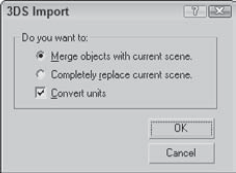
Figure 3.7. The 3DS Import dialog box enables you to merge objects into or completely replace the current scene.
If any of the object names in the imported scene match those in the current scene, an Import Name Conflict dialog box opens, allowing you to rename the imported objects, or you can Skip or Cancel the import.
Max can import several different formats, including the following:
Autodesk (FBX)
3D Studio Mesh, Projects, and Shapes (3DS, PRJ, SHP)
Collada (DAE)
LandXML/DEM/DDF
AutoCAD (DWG, DXF)
Flight Studio OpenFlight (FLT)
Motion Analysis (HTR, TRC)
Initial Graphics Exchange Standard (IGE, IGS, IGES)
Autodesk Inventor (IPT, IAM)
Lightscape (LS, VW, LP)
StereoLithography (STL)
OBJ Material and Object (OBJ)
VRML (WRL, WRZ)
VIZ Material XML Import (XML)
Note
Flight Studio OpenFlight support has been added to 3ds Max 2009.
The Files panel of the Preference Settings dialog box has a single option dealing with importing—Zoom Extents on Import. When this option is enabled, it automatically zooms all viewports to the extent of the imported objects. Imported objects can often be scaled so small that they aren't even visible. This option helps you to locate an object when imported.
In addition to importing, you'll sometimes want to export Max objects for use in other programs. You access the Export command by choosing File
Max can export to several different formats, including the following:
Autodesk (FBX)
3D Studio (3DS)
Adobe Illustrator (AI)
ASCII Scene Export (ASE)
AutoCAD (DWG, DXF)
Collada (DAE)
Initial Graphics Exchange Standard (IGS)
Flight Studio OpenFlight (FLT)
JSR-184 (M3G)
Lightscape Material, Blocks, Parameters, Layers, Preparations, and Views (ATR, BLK, DF, LAY, LP, VW)
Motion Analysis (HTR)
Publish to DWF (DWF)
StereoLithography (STL)
Shockwave 3D Scene Export (W3D)
VRML97 (WRL)
Autodesk has a host of other products that deal with 3D including Maya and MotionBuilder, so you may find yourself having to move scene files between Max and Maya at some time. The best format to transport files among Max, Maya, and MotionBuilder is the FBX format. Autodesk controls this format and has endowed it with the ability to seamlessly transport files among these packages.
Tip
The FBX format also is the format to choose when transferring files back and forth with Softimage XSI.
The FBX format includes support for all the scene constructs, including animation, bone systems, morph targets, and animation cache files. It has an option to embed textures with the export file or to convert them to the TIF format. Other import and export settings deal with the system units and world coordinate orientation. You also have the ability to filter specific objects. The FBX Import and FBX Export dialog boxes are shown in Figure 3.8.
Note
The FBX import and export features have been improved in 3ds Max 2009.
The FBX import and export dialog boxes include the ability to save and load configuration presets. This is helpful because once you figure out the correct settings to get models in and out of Max, you can save the preset and instantly select it the next time you need to move a file. There is also a button that lets you check for updates to the FBX format online.
Note
The FBX import/export option supports the Collada (DAE) file format, which is a group working to establish a universal format for exchanging 3D data.
When exporting the to FBX format, you have a Type option that you can use to export the file as an ASCII text file or as a Binary file. Binary files are typically smaller, but ASCII files can be edited in a text editor. If you need to export a Max file for use on an older version of Max, be sure to select an older FBX version in the FBX Version drop-down list.
The OBJ format is a text-based format that has been around since the early days of Wavefront, an early 3D package. It is a common format and used to exchange 3D data with a variety of programs, including Mudbox and Poser.
One aspect of the OBJ format is that it separates the model data and the texture data into two different files. The OBJ file holds the geometry data and the MTL file holds the texture data. Previous versions of Max required that you import each of these data files separately, but the new OBJ workflow imports these two data files together. The new OBJ workflow is a plug-in developed by GuruWare.
Note
The OBJ import and export features have been improved in 3ds Max 2009.
The new OBJ import and export workflow is much smoother and automatically gets the right materials and textures for the object. The dialog box for each is shown in Figure 3.9.

Figure 3.8. The FBX Import and Export dialog boxes provide the best way of transferring among Max, Maya, and MotionBuilder.

Figure 3.9. The OBJ Import and Export dialog boxes provide another excellent choice for transporting files to other packages.
The OBJ Export dialog box includes presets for most common 3D apps including Amapi Pro, Blender, Bryce, Carrara, Cinema-4D, DAZ Studio, Deep Paint, Hexagon, Lightwave, Maya, Modo, Motion Builder, Mudbox, Poser, Realflow, Rhino, Silo, Softimage XSI, UV Mapper, VUE, Worldbuilder, and ZBrush.
Clicking the Map Export button lets you specify the export map path where the textures for the scene are saved. You also can automatically convert the maps to a specific size or format. For each map format, you can configure the bits per pixel and any compression settings.
If you click the Presets button in the OBJ Export dialog box, then the export options for each format are shown in a table, like the one in Figure 3.10. Each of these settings can be quickly altered using this dialog box.
The JSR-184 export option lets you save a scene to a format that can be viewed on mobile devices that support the Java 2 Micro Edition standard interface, such as mobile phones and PDA devices.
Because wireless devices have such a limited bandwidth, the JSR-184 Exporter dialog box, shown in Figure 3.11, includes several options for optimizing the exported scene. This dialog box lists the Max scene hierarchy, the JSR-184 scene hierarchy, and the parameters for the selected scene object. Using the toolbar buttons at the top of the dialog box, you can change the hierarchy that is to be exported.
Before a scene can be exported, the Max scene must include a camera and you must specify an Active Camera in the JSR-184 Exported dialog box. When a material map is selected from the JSR-184 hierarchy list, the Texture Tool icon on the toolbar becomes active. Clicking this button opens the Texture Tool dialog box, shown in Figure 3.12, where you can precisely control the size and format of the exported maps.

Figure 3.12. The Texture Tool lets you specify the exact size of texture maps to be exported for mobile devices.
To view the exported M3G files, the default installation of Max includes an M3G Player, which can be found along with the other Max programs in Start
Note
The JSR Viewer application is built using Java. If you're having trouble with the viewer, try installing the latest Java version from the installation DVD.
The Design Web Format (DWF) is an ideal format for displaying your textured models to others via the Web. It creates relatively small files that can be attached easily to an e-mail. You can use the File
Saved files can be viewed in the Autodesk DWF Viewer, shown in Figure 3.13. The Autodesk DWF Viewer can be downloaded for free from the Autodesk Web site. This provides a way for users without Max installed to view models.
The Autodesk DWF Viewer is automatically installed along with 3ds Max. If you want to view the exported files in the viewer, simply enable the Show DWF in Viewer option in the DWF Publish Options dialog box. The viewer includes controls for transforming the model, changing its shading and view, and printing the current view.
In addition to the menu commands found in the File menu, Max includes a couple of utilities that export specific information: the Lighting Data Export Utility and the Material XML Exporter Utility. You can access these utilities from the Utilities panel in the Command Panel by clicking the More button and selecting them from the pop-up list that appears.
The Lighting Data Export Utility exports exposure control data for a scene's Illuminance and Luminance values. These files can be saved as PIC or TIF files, which you can select in the 2D Lighting Data Exporter rollout. You also can set an image's Width and Height dimensions.
Warning
Exposure Control must be enabled for this utility to be enabled. You can learn about exposure control in Chapter 45, "Using Atmospheric and Render Effects."
The Material XML Exporter Utility exports a selected material to an XML file format, where it can be easily shared with other users. After you select this utility, the Parameters rollout offers four options for selecting the material to export: the Material/Map Browser, the Object List, Pick Object in Scene, and All Objects in Scene.
The utility also offers several export options including Native XML, export to an Autodesk Tool Catalog, and using an XSLT template. You also can select to export the material with a thumbnail and along with its mapping modifiers.
In most companies, a professional creative team uses an advanced vector drawing tool such as Illustrator to design the company logo. If you need to work with such a logo, learning how to import the externally created file gives you a jumpstart on your project.
Note
When importing vector-based files into Max, only the lines are imported. Max cannot import fills, blends, or other specialized vector effects. All imported lines are automatically converted to Bézier splines in Max.
Although Max can draw and work with splines, this feature takes a backseat to the vector functions available in Adobe Illustrator. If you have an Illustrator (AI) file, you can import it directly into Max.
To import Adobe Illustrator files into Max, follow these steps:
Within Illustrator, save your file as "Box It Up Co logo" using the .ai file format by choosing File

Note
When saving the Illustrator file, don't use the latest file format. For this example, I've saved the file using the Illustrator 8 format instead of the latest Illustrator CS, CS2, or CS3 formats.
Figure 3.14 shows a logo created using Illustrator.
Open Max, and choose File

A file dialog box opens.
Select Adobe Illustrator (AI) as the File Type. Locate the file to import, and click OK.
The AI Import dialog box asks whether you want to merge the objects with the current scene or replace the current scene.
For your purposes, select the replace the current scene option and click OK.
The Shape Import dialog box asks whether you want to import the shapes as single or multiple objects. Select multiple, and click OK.
Figure 3.15 shows the logo after it has been imported into Max. Notice that all the fills are missing.
Note
Spline objects that are imported from Illustrator appear in Max as Editable Spline objects. You can learn more about Editable Splines in Chapter 12, "Drawing and Editing 2D Splines and Shapes."
With all these various files floating around, Max has included several utilities that make working with them easier. The Utilities panel of the Command Panel includes several useful utilities for working with files. You can access these utilities by opening the Utilities panel and clicking the More button to see a list of available utilities.
The Asset Browser utility is the first default button in the Utility panel. Clicking this button opens the Asset Browser window. The Asset Browser resembles Windows Explorer, except that it displays thumbnail images of all the supported formats contained within the current directory. Using this window, shown in Figure 3.16, you can browse through directory files and see thumbnails of images and scenes.
Note
Even though thumbnails aren't visible in Windows Vista, thumbnails are visible when you use Asset Browser.
The supported file types include AVI, BMP, CIN, CEL, DDS, GIF, HDRI, IFL, IPP, JPEG, MPEG, PNG, PSD, MOV, RGB, RLA, RPF, VST, TIF, and YUV. These types are the same ones that the File
Tip
Open and display the Asset Manager within a viewport by right-clicking the viewport title and choosing Views
You also can drag and drop files from the Asset Browser window to Max. Drag a scene file, and drop it on Max's title bar to open the scene file within Max. You can drop image files onto the map buttons in the Material Editor window or drop an image file onto a viewport to make a dialog box appear, which lets you apply the image as an Environment Map or as a Viewport Background, respectively.
The Asset Browser window is modeless, so you can work with the Max interface while the Asset Browser window is open. Double-clicking an image opens it full size in the Rendered Frame window.
The Asset Browser also can act as a Web browser to look at content online. When the Asset Browser first opens, a dialog box reminds you that online content may be copyrighted and cannot be used without consent from the owner.
The Display menu includes three panes that you can select. The Thumbnail pane shows the files as thumbnails. You can change the size of these thumbnails using the Thumbnails menu. The Explorer pane displays the files as icons the same as you would see in Windows Explorer. The Web pane displays the Web page for the site listed in the Address field.
To view Web sites, you need to be connected to the Internet. The Asset Browser can remember your favorite Web sites using the Favorites menu. The Asset Browser window also includes the standard Web browser navigation buttons, such as Back, Forward, Home, Refresh, and Stop. You also can find these commands in the Browse menu.
Max keeps thumbnails of all the images you access in its cache. The cache is a directory that holds thumbnails of all the recently accessed images. Each thumbnail image points to the actual directory where the image is located. Choose File
Choose File
Another useful utility for locating files is the Max File Finder utility, which you get to by using the More button in the Utilities panel. When you select this utility, a rollout with a Start button appears in the Utility panel. Clicking this button opens the MAXFinder dialog box. Using MAXFinder, you can search for scene files by any of the information listed in the File Properties dialog box.
You can use the Browse button to specify the root directory to search. You can select to have the search also examine any subfolders. Figure 3.17 shows the MAXFinder dialog box locating all the scene files that include the word blue.
When a scene is created, image and object files can be pulled from several different locations. The Resource Collector utility helps you consolidate all these files into one location. The settings for this utility appear in the Parameters rollout in the Utility panel of the Command Panel, as shown in Figure 3.18. The Output Path is the location where the files are collected. You can change this location using the Browse button.
The utility includes options to Collect Bitmaps, to include the Max scene file, and to compress the files into a compressed WinZip file. The Copy option makes copies of the files, and the Move option moves the actual file into the directory specified in the Output Path field. The Update Materials option updates all material paths in the Material Editor. When you're comfortable with the settings, click the Begin button to start the collecting.
The File Link Manager utility (which also can be accessed using the File
This utility is divided into three panels—Attach, Files, and Presets. The Attach panel includes a File button to select and open a DWG or DXF file. The Attach panel also includes options to rescale the file units, a button to select which layers to include, and a button to attach the file. The Files panel displays each linked AutoCAD file along with icons to show if the linked file has changed. A Reload button allows you to click to reload the linked file within Max. The Preset panel lets you define file linking presets.
To make accessing needed files from the Web even easier, Autodesk has created a technology known as i-drop that lets you drag files from i-drop supported Web pages and drop them directly into Max. With i-drop, you can drag and drop Max-created light fixture models, textures, or any other Max-supported file from a light manufacturer's Web site into your scene without importing and positioning a file. This format allows you to add geometry, photometric data, and materials.
As you work with files, several dialog boxes in Max supply you with extra information about your scene. You can use this information to keep track of files and record valuable statistics about a scene.
If you like to keep statistics on your files (to see whether you've broken the company record for the model with the greatest number of faces), you'll find the Summary Info dialog box useful. Use the File
The Plug-In Info button on the Summary Info dialog box displays a list of all the plug-ins currently installed on your system. Even without any external plug-ins installed, the list is fairly long because many of the core features in Max are implemented as plug-ins. The Summary Info dialog box also includes a Save to File button for saving the scene summary information as a text file.
As the number of files on your system increases, you'll be wishing you had a card catalog to keep track of them all. Max has an interface that you can use to attach keywords and other descriptive information about the scene to the file. The File
Note
You also can view the File Properties dialog box information while working in Windows Explorer by right-clicking the file and selecting Properties. Three unique tabs are visible: Summary, Contents, and Custom. The Summary tab holds the file identification information, including the Title, Subject, Author, Category, Keywords, and Comments.
Sometimes looking at the thumbnail of an image isn't enough to help you decide whether you have the right image. For these cases, you can quickly load the image in question into a viewer to look at it closely. The File
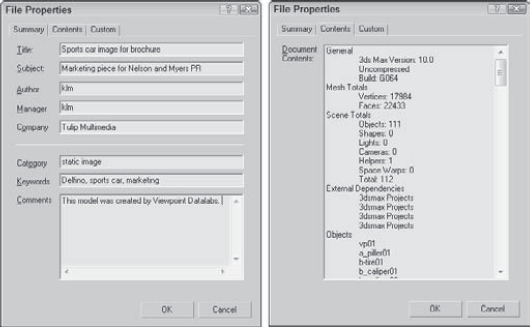
Figure 3.20. The File Properties dialog box contains workflow information such as the scene author, comments, and revision dates.
Note
The Rendered Frame Window is discussed in more detail in Chapter 22, "Learning to Render a Scene."
The View File dialog box includes several controls for viewing files. The Devices and Setup buttons let you set up and view a file using external devices such as video recorders. The Info button lets you view detailed information about the selected file. The View button opens the file for viewing while leaving the View File dialog box open. The Open button opens the selected file and closes the dialog box. At the bottom of the View File dialog box, the statistics and path of the current file are displayed.
The View File dialog box can open many types of files, including Microsoft videos (AVI), MPEG files, bitmap images (BMP), Kodak Cineon images (CIN), Combustion files (CWS), Graphics Image Format images (GIF), Radiance HDRI image files (HDR), Image File List files (IFL), JPEG images (JPG), OpenEXR image files (EXR), Portable Network Graphics images (PNG), Adobe Photoshop images (PSD), QuickTime movies (MOV), SGI images (RGB), RLA images, RPF images, Targa images (TGA, VST), Tagged Image File Format images (TIF), Abekas Digital Disk images (YUV), and DirectDraw Surface (DDS) images.
You use the Gamma area on the View File dialog box to specify whether an image uses its own gamma settings or the system's default setting, or whether an override value should be used.
Working with files lets you save your work, share it with others, and reload it for more work. This chapter covered the following topics:
Creating, saving, opening, merging, and archiving files
Understanding the various import and export types
Importing models from other programs, such as Illustrator and Poser
Working with the file utilities, such as the Asset Browser
Using the Summary Info and File Properties dialog boxes to keep track of scene files
By now, you should be feeling more comfortable with the user interface, but if you want to make some changes to the interface, the next chapter covers how to customize it.

